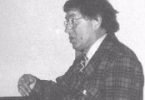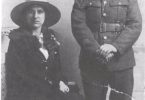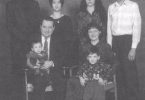I got my first guitar by mail order from WWVA, Wheeling, West Virginia. When I was younger, I was willing to walk three miles to hear this country and western radio station. This was near Moncton, N.B. at a place called Coates Mills, a lumber mill area in those days. By snaring rabbits and trapping muskrats and weasels, I was able to raise all the money myself.
I was born in Alberta and at the age of two, my father was killed in a mine at Brule. My grandmother and my uncle came out to help my mother and took a couple of us kids east. I lived and went to school at Coates Mills until I was nineteen years old. This was a farming area. Some extra money was earned by cutting timber in winter. During this time, the Dirty Thirties, I went to work on an extra gang, pay was twenty-five cents an hour. The job was to work on the train track, raising the track, tamping ties, etc. Board was a boxcar with few conveniences but meals were provided in the dining car. I also worked on the log drives for Irvings.
Fisher Hill was part of a land grant for my great grandfather. This is where we went to church at a Baptist Church which is still standing today. All other houses have been torn down. The land has gone back to nature, almost a shame when it was originally cleared with oxen and grubhoe.
I hadn’t seen my family since I was two years old. And with Hitler starting to throw his weight around and war on the horizon, I wanted to come out and see my family. My mother had remarried and there were eleven children in the family all told, Fishers and Lewises.
There was an excursion on the railway in September, 1935 so I scrounged up enough money to buy a ticket and come home on a forty-five day excursion. At this time there were several cars in Canmore, one of which belonged to the Rivas, and Mary Riva took me home from the station. I arrived here the same time that the Doukhobors killed two police officers in Manitoba and two R.C.M.P. at the Banff Park gates. So there was a lot of excitement around here when I arrived. The Mounties shot one of the Doukhobors but two escaped. They were later shot by Bill Neish, Banff park warden, whom I got to know later and consider him a real hero.
My family talked me into staying and my ticket ran out so I didn’t have any choice. I got a job working at Davidson’s Dairy milking cows for twenty-five dollars a month. That helped pay the milk bill for the family. In the spring, I got a job with Ed Erickson driving logs on the Kananaskis River. We loaded them on flat cars and they were shipped to the mine as mine timbers. I got sick from drinking the river water, probably beaver fever, and when I recuperated a friend of mine told me that Brewsters, who had a ranch at Seebe, Alberta, needed a teamster. So I went down and saw Claude Brewster. He hired me right away. Alvin Guinn and Olie Rasmussen were cowboys on the ranch and showed me how to throw the diamond hitch. Next morning I left for Kananaskis Lakes, a two-day trip where I drove a team with a slip raising the dam between the Upper and Lower lakes. This was in 1936. When I finished that job, I continued to work for Brewsters as a cowboy.
Brewster and Ed Ogan, who had a ranch at Canmore, were outfitting “The TrailRiders of the Canadian Rockies”. They needed a cowboy singer. Wilf Carter had been the entertainer for the Trail Riders and he had left for New York. A cowboy singer was needed to Entertain that year. I went to Banff to audition with Colonel Moore. Actually because I was so shy, Brewsters almost had to drag me. But after the audition, I got the job and they said I would do fine. I was entertaining there for several years, my picture was on the front of the Trail Rider magazine, just as Wilf Carter had previously. I got ten dollars a day. John Murray Gibbon was the publicity director of the CPR. I entertained the trail riders. Gibbon’s favorite song was “Down by the Railroad Track’. Nick Morant who was the CPR photographer took pictures of me singing for the trail riders. So I continued to play for people who enjoyed my music. I started playing with my next door neighbor, Tom Lytkowski who was real good on the violin. We played together for almost forty years. We entertained people from all over the world at conventions and tours. We played at the Rafter Six ranch for twelve years. We played for Brewsters at Banff and at Seebe, at the doughnut tents. The hole in the roof allowed them to have a nice bonfire in the middle of the tent with dancing room around. We also played at the Banff Springs Hotel when they had a western night. The Australians were especially appreciative and knew how to enjoy themselves.
When I was not working as an entertainer, I was working at the mine, or working in Exshaw for three dollars a day. Since the mine paid $4.00 plus, I worked in Canmore.
Back then, there were no holidays, no extra money for overtime, and there was no unemployment insurance. If you wanted to go somewhere, you had to quit your job. You couldn’t get time off. You took a chance on getting rehired when you came back. In 1939 I wanted to go east to visit my grandfathers in NB and Cape Breton. So I had to quit my job and I went east on an excursion for forty-five days and visited all my relatives in the east. As I had learned to play the guitar and sing a lot of songs, my brothers, Ed and Vic, helped me learn to play the guitar and so I was quite popular with my relatives down there and we had a lot of fun together playing music.
When I came back I didn’t have a job. I went to work in Exshaw again. Eventually I got hired at Canmore. I worked there until I joined up, 1942. I was in the Signals during the war as a dispatch rider in England and Europe. I was in the invasion and landed in France on a landing craft on the beach on my birthday, 29th of June. I was four years in the service.
After the war, when I returned, I bought a house from Charlie Hubman for 1750 dollars with a nice garden and garage. I didn’t buy a car for three years as I was so tired of driving from my war experience. I got my same job back at the mine, the policy being to rehire people when they returned from the war.
There was no water and sewer service in Canmore, everyone had their own well point on the town side of Canmore.The mineside had running water. You had to have a septic tank to dispose of your sewage or an outside toilet. Main Street used to have a wooden sidewalk. There was a big flood in 1946. It flooded around my house. The neighbor’s garden was covered in water. It washed out the railroad and ran over the highway. This was the 24th of May. You could hear the water running down Cougar Canyon all over town. The railway was closed and the debris was running over the highway. There have been floods since then I worked at the mine for thirty-three years and was laid off after Dillingham started running it. Some of the new ideas didn’t work very well. Then I worked for Banff National Park until I retired. I worked as utilities foreman. We covered all the area from Banff to the Columbia Ice Fields.
Since 1980, I have kept my music and entertaining. Now I just entertain mostly at the hospitals, Canmore and Banff, the people in extended care, and at the seniors’ centers,. They all seem to enjoy the old songs and it brings back good memories.
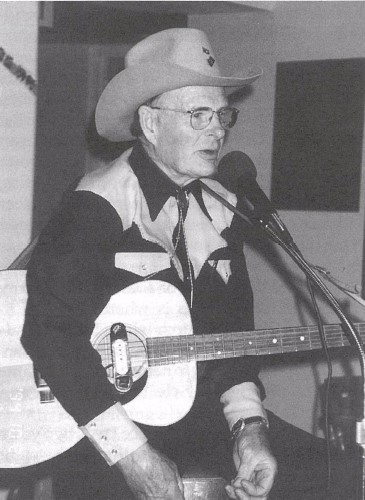
George Fisher
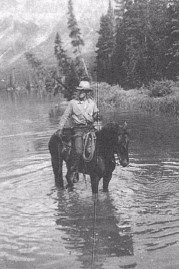
George Fisher at Spray Lakes
In Canmore Seniors at the Summit, ed. Canmore Seniors Association, 2000, p. 85-87.


